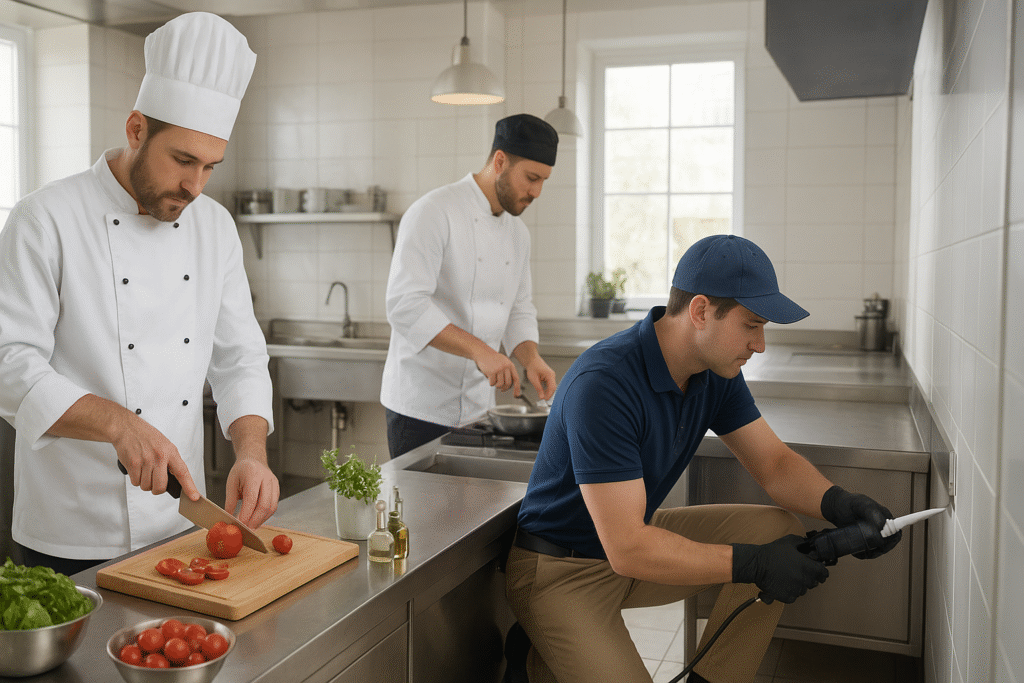Pest Control in Restaurants: Maintaining Hygiene and Safety
- Pest_Control

Table of Contents
Introduction
Restaurants are places where people gather to enjoy good food, comfort, and ambiance. However, even the most well-designed dining spaces can face one persistent challenge — pests. From cockroaches and rodents to flies and ants, these unwelcome visitors can compromise hygiene, damage your reputation, and even result in health code violations. Effective pest control is not just a recommendation; it’s a necessity to ensure safety, hygiene, and compliance in the food industry.
Maintaining high standards of cleanliness requires a proactive approach. By implementing a structured pest management plan, restaurant owners can protect their kitchens, customers, and credibility from potential infestations.
Why Pest Control Is Crucial in Restaurants
Restaurants operate under strict hygiene regulations. A single pest sighting can quickly tarnish a brand’s image and lead to severe consequences, including fines or closure. Pests thrive in environments where food, warmth, and moisture are readily available — exactly what a busy kitchen offers.
Beyond aesthetic and reputational damage, pests pose real health risks. Cockroaches and flies carry bacteria such as Salmonella and E. coli, while rodents can contaminate food supplies and cause property damage. By investing in regular pest control, restaurant owners safeguard both their customers’ health and their business operations.
Common Pests Found in Restaurants
Understanding which pests commonly invade restaurants helps in implementing targeted control measures. Here are a few that frequently appear:
- Cockroaches: Thrive in dark, moist areas like drains and kitchen corners. They multiply fast and spread harmful pathogens.
- Rodents: Chew through packaging and electrical wiring, contaminating food and causing structural damage.
- Flies: Often drawn to waste bins and food residue, they spread diseases through contact with food surfaces.
- Ants: Enter through small cracks in search of sweet or greasy foods, forming large colonies in no time.
Identifying early signs such as droppings, grease marks, or unusual odors is key to preventing a full-blown infestation.
Implementing Effective Pest Control Strategies
For restaurants to remain compliant and pest-free, prevention is better than cure. Here’s how to establish a strong defense against infestations:
- Regular Cleaning and Maintenance:
Ensure all kitchen areas, including under appliances, are cleaned daily. Food waste should be properly sealed and disposed of regularly. - Proper Food Storage:
Keep ingredients in airtight containers and maintain a first-in, first-out inventory system to reduce spoilage and attractants. - Seal Entry Points:
Inspect and seal cracks, gaps, and openings around pipes, windows, and doors where pests can enter. - Routine Inspections:
Schedule professional pest inspections at least once every quarter to detect early signs and address them promptly. - Employee Training:
Educate staff to recognize pest activity and report it immediately to management or pest control experts.
By integrating these measures, restaurant owners create an environment that discourages pests from establishing a foothold.
Benefits of Professional Pest Control Services
Partnering with a professional pest control company offers multiple advantages for restaurants:
- Expert Knowledge: Specialists understand pest behavior and can design customized solutions based on the layout and needs of your establishment.
- Safe Solutions: Licensed technicians use eco-friendly, food-safe treatments that protect both staff and customers.
- Compliance Assurance: Regular inspections and documentation help meet local health regulations and food safety standards.
- Long-Term Prevention: Professionals provide continuous monitoring and maintenance to prevent recurring infestations.
Ultimately, professional pest control gives restaurant owners peace of mind — knowing their space remains safe, hygienic, and customer-ready.
Building a Reputation for Hygiene and Safety
For restaurants, reputation is everything. Word spreads fast, and a single incident involving pests can affect customer trust and online reviews. Consistent pest control practices, transparent hygiene policies, and regular maintenance reinforce the message that you prioritize health and safety above all else.
A pest-free environment enhances customer confidence and contributes to a positive dining experience. Over time, it becomes part of your brand identity — one that reflects professionalism, care, and excellence in every dish served.
Conclusion
Maintaining hygiene and safety in restaurants is a continuous process that extends beyond delicious food and pleasant service. It involves careful attention to every detail, from waste management to preventive pest control. Partnering with trusted pest control professionals ensures your restaurant remains clean, compliant, and inviting — where guests can dine with peace of mind.
With the right strategy in place, restaurant owners can focus on what they do best: creating exceptional dining experiences in an environment that’s as clean and safe as it is welcoming.
Need a professional touch?
Don’t wait until pests take over—stay one step ahead with Blue Diamond’s pest control.



Frequently Asked Questions (FAQs)
Why is pest control important in restaurants?
Pest control prevents contamination, protects food quality, and ensures compliance with health and safety regulations critical to the food service industry.
How often should restaurants schedule pest inspections?
Most experts recommend quarterly inspections, though monthly checks are ideal for high-traffic or open-kitchen establishments.
Are pest control treatments safe around food?
Yes. Professional pest control companies use certified, food-safe treatments designed specifically for restaurant environments.
What are the signs of a pest infestation in restaurants?
Look for droppings, grease marks, strange odors, gnawing damage, or live pest sightings, especially near food storage and waste areas.
How can restaurant staff help prevent pests?
Training employees to maintain cleanliness, properly store food, and promptly report any pest signs plays a major role in prevention.
Share this
Book Your
Service In
30 Seconds
- 30 years of experinece
- Served 40,000+ clients across UAE
- Dubai Municipality Approved
- Eco - friendly products safe for All
- Cost Effective
- 24/7 Customer support
Check out our Recent Blogs
The Importance of Regular Pest Inspections for Your Property
Frequently Asked Questions (FAQs) Introduction Importance is at the core of every decision a responsible property owner makes, especially when...
How Technology Is Transforming the Pest Control Industry
Introduction In recent years, technology has reshaped nearly every industry — and pest control is no exception. What was once...



